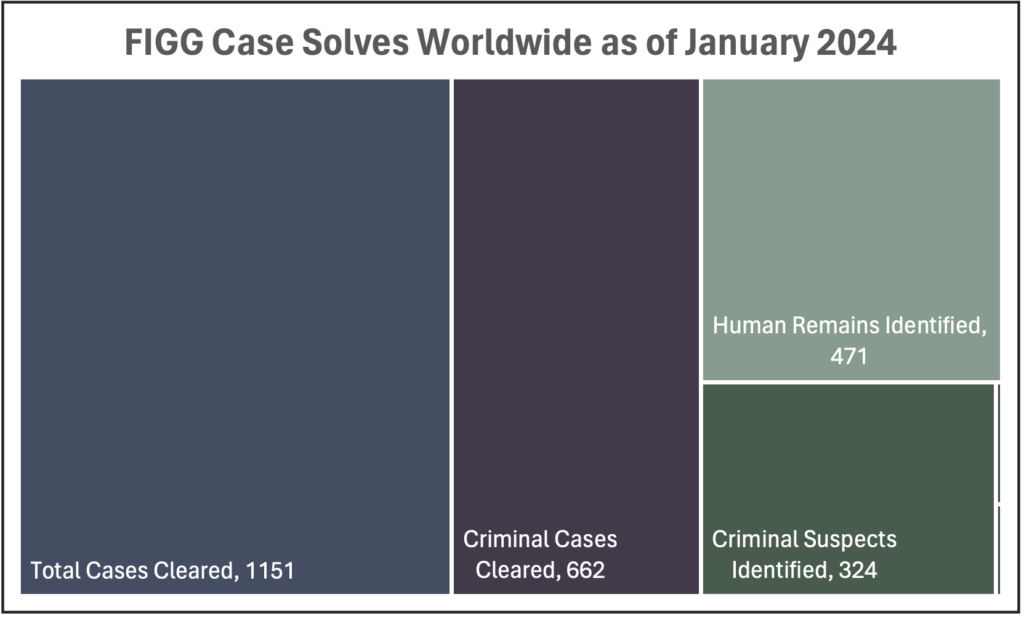I spent much of January updating the 2023 dataset of FIGG cases cleared, and while I was doing that there were several important developments and case solves. Overall, January was a busy month, with 22 FIGG case solves, including 12 new criminal case solves that identified 6 individual suspects, and 10 human remains identifications.

This month, I’ve chosen to highlight one human remains and one criminal suspect identification that are significant in the field, or that highlight particular skill in genetic genealogy.
January Human Remains Case Solve
The identification of 64-year-old Ada Kaplan (Case ID 2146) by the DNA Doe Project is significant, because it is the first recorded case of a decedent of Ashkenazi Jewish ancestry being identified through FIGG.
Ada Kaplan’s remains were recovered from a vineyard in Arvin, California on March 29, 2011. She was nude and had no personal effects with her. Her remains were in an advanced state of decomposition and her head and thumbs were missing. She had a surgical scar on her left breast.
The DNA Doe project began working on this investigation in June of 2020, in partnership with the Kern County Sheriff’s Office and the Kern County Medical Examiner’s Office. This case was especially challenging and took longer than the average FIGG case to solve due to Kaplan’s Ashkenazi ancestry (in my paper, I found that the average time to case clearance using FIGG was 12.1 months). Team leader Missy Koski stated that an expert in Ashkenazi Jewish ancestry was brought in to assist in the investigation.
In the end, Kaplan’s family tree was built a total of 8 generations back. Three of her grandparents immigrated to America from Eastern Europe, so many of the necessary records were located abroad. Genealogical investigations involving those of Ashkenazi ancestry are often complicated due to missing records, endogamy, and common surnames.
Research shows that two-fifths of all Ashkenazim are descended from just four women. A recent article published in the journal Cell sheds further light on the original founder event. In this research, a team led by Shai Carmi and David Reich studied a group of remains unearthed in Erfurt, Germany from the 14th century and found that modern Ashkenazim formed from the union of two groups: one with a greater proportion of Middle Eastern ancestry, and one with greater admixture from Eastern and Central Europe. There were very few outside genetic influences on this group from the 13th to the 19th centuries. These factors have contributed to the endogamy seen in modern Ashkenazi populations.
For those readers interested in Ashkenazi genealogy, FamilySearch has some good resources in their Knowles Collection. I enjoyed Kevin Alan Brook’s recent Maternal Lineages of Ashkenazic Jews (Academic Studies Press, 2022), as well as Arthur Kurzweil’s From Generation to Generation: How to Trace Your Jewish Genealogy and Family History (Jossey-Bass, 2024), and Dan Rottenberg’s Finding Our Fathers: A Guidebook to Jewish Genealogy (Genealogical Publishing Company, 2009 reprint) (I get no revenues from these recommendations, they’re just good books).
Congratulations to the DNA Doe Project on a tough case solve that breaks new ground in investigative genetic genealogy.
January Criminal Suspect Identification
There were several criminal suspects identified this month, including:
- Eric Dorwart (Case ID 2144-2145) who was identified by Othram in the sexual assault of two young children in Leacock Township, Pennsylvania.
- William Taylor (Case ID 2147) who was identified by the Toronto Police Service in the murder of Kevin McBride.
- The identification of Thomas Williams (Case ID 2152-2153) by DNA Labs International in the attempted murder and kidnapping of three victims in Greenfield, Indiana.
- The identification of Alan Wilmer (Case ID 2157-2159) in the murders of Robin Edwards, David Knobling, and Teresa Howell in Virginia – homicides that may be connected to the ‘Colonial Parkway Murders.’
This makes January 2024 one of the busiest months to date for criminal case solves.
I would particularly like to highlight the identification of Todd Gallant (Case ID 2161) in Charlottetown, Prince Edward Island – a case solved by Wyndham Forensics Group, Convergence Investigative Genetic Genealogy, and the Charlottetown Police Service.
This case is noteworthy, and not only because it was solved in beautiful PEI, Canada – a place I have loved since childhood. This is the first reported FIGG case solve in Atlantic Canada, and reportedly PEIs only unsolved cold case homicide. This shows the potential for FIGG to clear cold cases – even very old ones, as I discussed in my previous post.
The case was heart wrenching because it involved the sexually motivated homicide of a popular English teacher, 36-year-old Byron Carr, who was killed by a young Todd Gallant after the two went home from a bar together. This happened at a time when there was much social stigma against being openly gay, and this contributed to a lack of safety within the community. The police are investigating this as a hate crime. Chief Brad MacConnell stated that police may have taken the case less seriously at the time because of the victim’s sexual orientation.
It was reported that a few hours after strangling Carr, the suspect returned to the apartment with an accomplice to destroy evidence. They stabbed the victim and stole his wallet. On the wall, they wrote the chilling message, “I will kill again” – a message that terrorized the community for years after. Gallant, now 56, has been charged with first-degree murder and interfering with human remains. Another individual was arrested and released but has not been charged.
Sexually motivated homicides dominate FIGG criminal cases cleared. This case demonstrates the particular vulnerabilities experienced by members of the LGBTQ+ community. One of the data points that I collect is whether victims are especially vulnerable because of their age (over 65 or under 20), whether they were experiencing a lack of housing or a mental illness, or whether they were engaged in sex work at the time of the offence. Because of this case, I have added being victimized by an offence motivated by hatred.
Vulnerabilities not only increase criminal offending against marginalized groups, but prejudice can hinder police investigations. Although FIGG is instrumental in solving these cases, it takes more than technology to turn this around – it takes forensic and law enforcement communities that are committed to upholding the rights of everyone and making sure that each victim receives the full protection of the law.
Feel free to leave comments and information about case solves below. You may also access a copy of the FIGG Cleared Case Reporting Form here.
Enjoy the 2024 I4GG Conference this weekend for its 10th anniversary! I will be attending virtually again, but I look forward to making it to San Diego in person next year.


